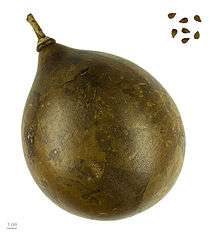Crescentia cujete
| Crescentia cujete | |
|---|---|
.jpg) | |
| Scientific classification | |
| Kingdom: | Plantae |
| (unranked): | Angiosperms |
| (unranked): | Eudicots |
| (unranked): | Asterids |
| Order: | Lamiales |
| Family: | Bignoniaceae |
| Genus: | Crescentia |
| Species: | C. cujete |
| Binomial name | |
| Crescentia cujete L. | |

Crescentia cujete, commonly known as the Calabash Tree, is species of flowering plant that is native to Central and South America. It is the national tree of St. Lucia. It is a dicotyledonous plant with simple leaves, which are alternate or in fascicles (clusters) on short shoots.[1] It is naturalized in India.[2]
It is also known as Calabacero (Spain), Cuité (Brazil) Totumo (Panama, Colombia, Venezuela and Peru), Tutumo (Bolivia), Taparo (Venezuela), Mate (Ecuador), Huinga (Peru), Pate (Peru), Cuyabra (Colombia), Jícaro (Mexico), Morro (Guatemala), Güira (Cuba), Cujete (Spain, Philippines), Miracle Fruit (Philippines), Kalbas (Dominica and St. Lucia), Higuera (Puerto Rico) and Rum tree (Sri Lanka).
The fruit, called Jícara, Bule, Tecomate, Guaje, Morro or Huacal in Mexico, is used to make small vessels for serving or drinking.
The tree shares its common name with that of the vine calabash, or bottle gourd, Lagenaria siceraria).
References
- ↑ GENTRY, A.H. 1996. A field guide to the families and genera of woody plants of northwest South America (Columbia, Ecuador, Peru), with supplementary notes on herbaceous taxa. University of Chicago Press. p. 265.
- ↑ Pharmacographia Indica page 40
External links
-
 Media related to Crescentia cujete at Wikimedia Commons
Media related to Crescentia cujete at Wikimedia Commons - Plant of the Week 31 January 2005: Calabash Tree (Crescentia cujete)
- Philippine Medicinal Plant